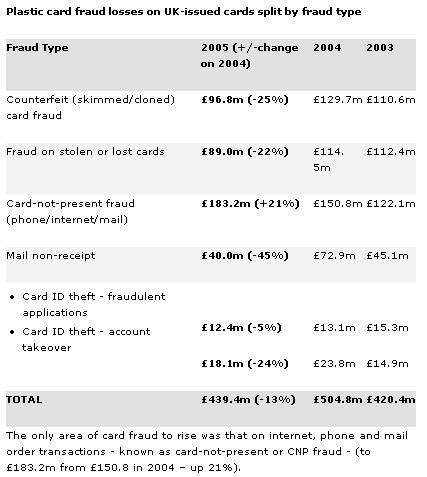
* Chip and PIN reduces counterfeit and lost and stolen fraud by
£58.4m - down 24%
* Reduction in all card fraud types except card-not-present
(internet, phone and mail order) fraud which rose by £32.4m - up 21%
Figures released today (7 March 2006) by APACS, the UK payments association, show total card fraud losses fell by 13% compared to 2004 (£439.4m in 2005 compared to £504.8m in 2004). This fall is attributed to chip and PIN which has already resulted in a reduction of nearly £60m in combined counterfeit and lost and stolen card fraud losses . a fall of 24% - and in mail non-receipt fraud, which fell by 45%.
Plastic card fraud losses on UK-issued cards split by fraud type:

However, the rate of increase has fallen for the first time since 2003* in part thanks to the increased use by retailers of checks on cardholder addresses and the three extra digits on the signature strip, and also online initiatives like Verified by Visa and MasterCard SecureCode.**
The next significant step in further protecting these non-face-to-face transactions will be to use chip and PIN security. This could, for example, involve customers using a chip and PIN card inserted into a small handheld reader and tapping in their PIN to generate a one-off number to verify each transaction. Cardholders can also greatly protect themselves against phone, internet and mail order fraud by taking good care of card and card details in the real world, which is where fraudsters most often get hold of this information. A simple checklist for cardholders is available from www.cardwatch.org.uk.
Fraud on a card stolen before the genuine cardholder receives it (mail non-receipt) fell sharply in 2005 (down by 45% to £40m) mostly because it has become more difficult for fraudsters to use stolen cards without the PIN, but also because less cards are being sent out than at the peak of the chip and PIN rollout. Chip and PIN is also impacting on cash machine fraud - helping combat skimming and pin-hole camera fraud and, as a result, losses at cash machines fell by 12% to £65.8m (£74.6m in 2004).
Following rises in previous years, 2005 also saw a fall in the level of card ID theft. Fraud caused by either account takeover or fraudulent applications fell by 17% to £30.5m (£36.9m in 2004). Card ID theft in the UK remains a very small proportion of overall fraud at just under seven percent.
As well as card fraud, organised gangs focus on other types of financial crime, notably online banking fraud and cheque fraud. Online banking fraud losses reached £23.2m in 2005 . almost double the previous year.s losses of £12.2m. These losses are mainly the result of phishing scams, where customers are duped into disclosing personal security information. Help and advice about preventing all types of online banking fraud is available at www.banksafeonline.org.uk. The site also contains updates on the latest scams, and enables consumers to report any suspicious e-mails or websites. Cheque fraud losses fell from £46.2m in 2004 to £40.3m in 2005 (a 13% drop).***
Sandra Quinn, director of corporate communications at APACS, comments .Seeing card fraud losses come down is cast-iron proof that chip and PIN is doing its job. Back in 2002 we forecast that fraud would have risen to £800m in 2005 if we didn.t make the move to chip and PIN so it.s heartening to see total losses well beneath this figure.
Of course, whilst our cards are safer than ever before, the fraudsters clearly aren.t going to give up so neither will we. Now chip and PIN is in place the banking industry is discussing how to leverage chip and PIN to better protect card-not-present transactions and we hope this will lead to progress later this year about what this means for cardholders and retailers..